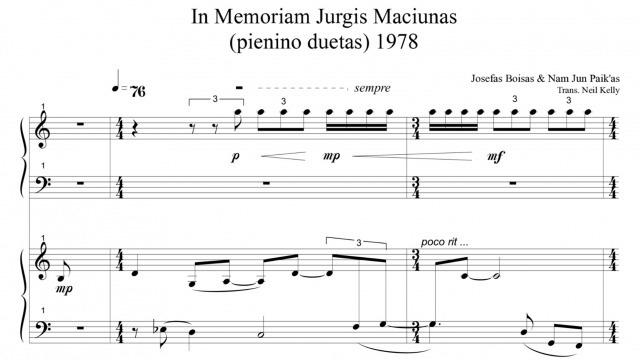
Consigning Anarchistic Noise to the Prison-house: Slave Pianos in Historical Context
In a purposefully misleading statement, the Melbourne-based art/music collective Slave Pianos (formed 1998 by Rohan Drape, Neil Kelly, Danius Kesminas, and Michael Stevenson) described themselves in 2000 as “a preservation society devoted to the collection, analysis, performance and recomposition of works in sound by visual artists.” In fact, the group’s irreverent project could be understood as an attack on the very idea of preservation, on institutions of cultural memory generally, and also on the sonic works of those artists who had the misfortune of attracting their attention.
Slave Pianos transcribed audio recordings of sound works by a wildly diverse range of artists (from Marco Fusinato and John Nixon to Louise Bourgeois, Joseph Beuys and Nam June Paik) into scores which were then played in “recitals” by a computer-controlled player piano. Reviewing one such event, Charles LaBelle observed that the group’s process of transcription for the piano “ultimately consigns a lot of anarchistic noise to the prison-house of ‘music’ and leaves formerly biting works toothless.” LaBelle was responding to the way the mechanical piano flattened and mercilessly homogenised live sound art recordings. However, he didn’t consider the subsequent consignment of the Slave Pianos archive (including recordings, scores and ephemera) into the prison-house of the museum collection, where it now sits alongside box sets of Fluxus editions and scores by John Cage.
This work-in-progress seminar will draw on collection research at the Art Gallery of New South Wales and the National Gallery of Australia to set the Slave Pianos archive into its art historical and museological context. In particular, it will pay attention to how the canonisation of experimental composers like Cage and countercultural groups like Fluxus led to the acquisition of their works by Australian museums through the 1980s. Elaborating Slave Piano’s links with local and international precedents including Peter Tyndall’s Slave Guitars project, John Nixon’s Anti-Music and George Maciunas’s development of Fluxus, it will consider the unruly productions of art and music communities as well as those who have tried (with varying degrees of seriousness) to organise and document them.
Dr Anna Parlane is an art historian and writer who is also interested in archives and collection management. She has held teaching positions at Monash University, University of Melbourne and University of Auckland, as well as curatorial roles at Auckland Art Gallery Toi o Tāmaki. As a 2025 William Dobell Visiting Fellow at ANU, Anna is researching the Melbourne-based art-music collective Slave Pianos. Anna is on the editorial boards of Memo Review and Index Journal, and has published in peer-reviewed and industry publications including the Australian and New Zealand Journal of Art, Index Journal, Burlington Contemporary, The Journal of New Zealand Studies, Discipline, Reading Room and Art in Australia. Her writing on Michael Stevenson’s exhibition Disproof Does Not Equal Disbelief (2021) at KW, Berlin, was published by KW and Sternberg Press.
This event will be held both on-campus and online via Zoom (a link to the online stream will be sent to registered attendees).
The School of Art & Design Seminar series will continue weekly on Tuesdays from 1-2pm, between 17 February and 21 October 2025, co-convened by Dr Alex Burchmore and Alia Parker.